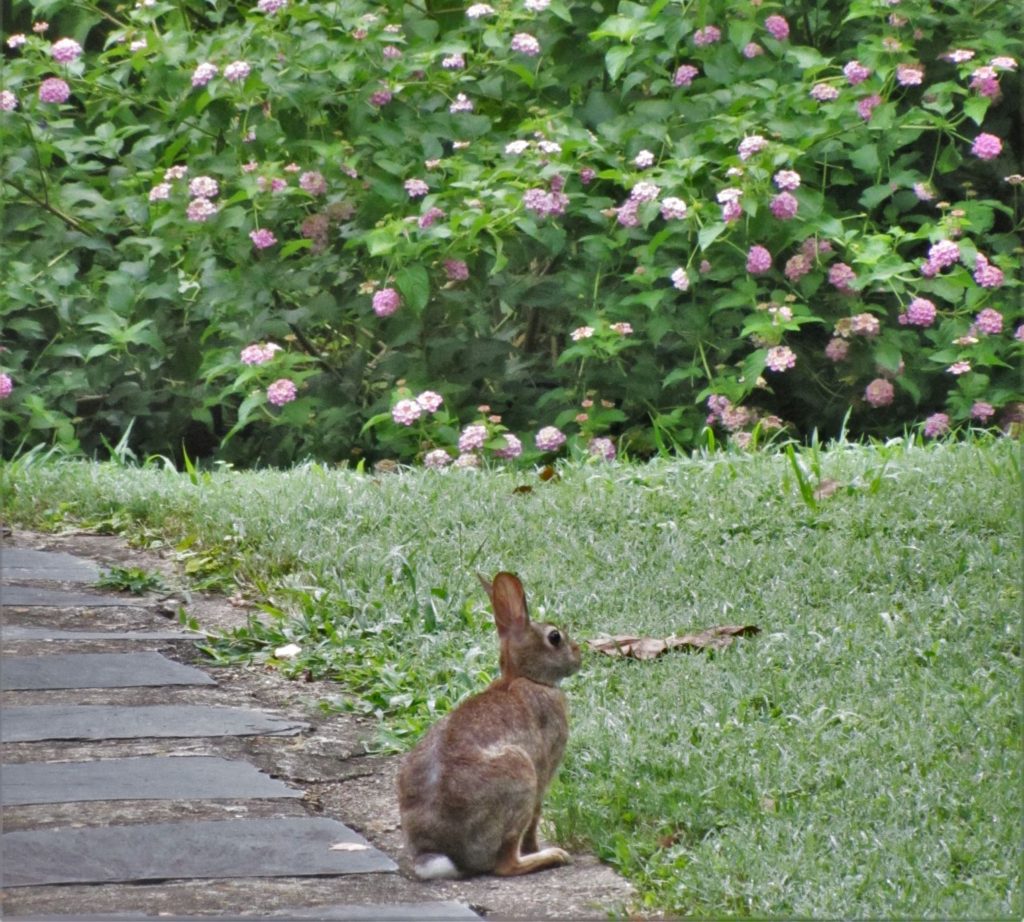The Lantana ‘Stand’
I never intended to create the Lantana stand. Never in my wildest gardening dream did I expect it to get this huge. There were no warning labels to prepare me for what it has become. And it all began so innocently…
In the beginning, there were only a lonely tea rose and a few New Guinnea impatiens, I. hawkeri, growing in the neat round bed in the center of our new front yard. We bought the house in July and moved in early August, and the round bed was the one spot of bright color in a sea of overgrown grass. There was a little plastic fence made to look like wrought iron that contained the flowers, and a metal bird bath held the center.
That August the old bird bath was dry. If anything other than mosquitoes buzzed around the flowers, I didn’t notice. While we were taming the rest of the yard the Impatiens bloomed serenely on. And then it turned cold, and the Impatiens perished in the first few frosts. Once I removed them, the bed looked empty, and I must have mulched it.
The following spring, we were charmed by the tiny golden Crocus that bloomed by late February in a few spots in that circle bed. Seedlings of the Impatiens appeared. And I decided that bed would be a terrific place to plant more roses and Iris.
We saw mature Peonies in the edge of the shrub border. Native Hibiscus grew nearby. Yet that summer of 2010 was when I first learned about the wildness of our new yard. Most of my plant purchases soon became fodder. The tiny Phlox plants I planted beside the new path on the side of the house disappeared, one by one, at night. Their tender root balls made perfect handles for voles to pull the entire plant down into their tunnels for breakfast.
I tried planting a new hedge of hybrid holly shrubs. That is how I learned that yes, deer will eat the tender new leaves on ornamental hollies. The hedge of I. x meservaea ‘Blue Girl’ and ‘Blue Boy’ hollies I planted with such enthusiasm didn’t last three weeks. They were first grazed down to twigs, and then they died. I also hadn’t learned to use deer repellent products like Milorganite and Plantskydd to protect new plantings, yet. That came years later.

By May of 2010 we had planted a few Lantana, along with Coleus, dusty miller, a few types of Iris, and some herbs in the round bed.
In the spring of 2011, I decided to plant some more Lantana camara in the round bed in the center of the front yard. I was ordering a lot of plants by then, since we hadn’t discovered a good nearby nursery, beyond the hardware stores. The little Lantanas looked sturdy. The website said that deer wouldn’t eat them. I had never grown Lantana before this garden, but I decided to give them a chance to do the job. Like the Impatiens, they were annuals, so it was a single season commitment.
The first Lantanas I ordered were so tiny when they came out of the box! I worried that we hadn’t ordered enough. But they arrived in bloom, and they never stopped blooming that entire summer. They grew quickly once they were planted. Best of all, they were always alive with butterflies, bees, hummingbirds, and songbirds.
We had hummingbirds our first summer, feeding on the huge rose of Sharon flowers that bloomed on spindly shrubs throughout the yard. I had intended to cut down the shrubs until I saw how the hummingbirds loved them. I could stand at the windows and watch hummingbirds and butterflies feed at the wide white and lavender flowers dotted around the house. Now, the butterflies and hummingbirds visited the circle bed in front, too.
Lantana camara is native in ‘tropical America,’ meaning Florida and the Gulf Coast, Mexico, parts of Central and South America, and in the West Indies. It is a small woody shrub whose woody stems can be used for making paper, its bark and leaves have a variety of medicinal properties, and its drupes are beloved by birds. Its leaves are antimicrobial and can function as a fungicide. Lantana leaves also repel biting insects like mosquitoes. It is a member of the Verbena family, and so contains essential oils in its leaves which deter grazing deer, and its bright, long-lasting flowers produce high quality nectar for wildlife.
In the beginning, I didn’t know that Lantana grows into a woody shrub. I just expected a neat little mound of summer flowers, perhaps a foot or two tall, to fill my flower bed with color. That first Lantana order included some of the Bandana series hybrids, and some of the popular ‘Ham and Eggs’ cultivar. The next spring, I ordered more since the Lantana had worked so well in that space.
Since I thought of the Lantana as groundcover, I also planted some English shrub roses in the bed, along with Echinacea, sage, Irises, dusty miller, Coleus, and of course, more bulbs. I was still experimenting, trying to figure out what would grow well in that space without attracting deer.
At some point, I learned that some varieties of Lantana can overwinter in our climate. L. ‘Ham and Eggs’ surprised me that first year by leafing out again from its base, the following spring. And soon enough, I discovered L. ‘Miss Huff.’

Native bees love Lantana, and can be found resting on its flowers in early morning. Here a Bumblebee feasts on L. ‘Ham and Eggs.’
“Miss Huff’ is a very special Lantana. It is hardy to Zone 7 and grows with epic enthusiasm. Its roots grow deep, its branches grow wide. It ignores heat and drought. Those deep, woody roots are key to its survival because they allow it to survive whatever weather may come. It covers itself in round clusters of flowers with orange, yellow, and pink tubular flowers often growing in the same cluster. The colors within a given cluster may change as the cluster opens, ages, and finally fades.
‘Miss Huff’ is a fast grower, too. It can grow to 6’ or more, tall and wide. The older the plant, the larger the growth can be in a single season because of the extensive roots that support it. After a season or two, the base of the plant develops into a thick, woody trunk that is several inches in diameter. While you may consider it an annual or a perennial at planting time, Lantana ‘Miss Huff’ is truly a flowering shrub.

Within only a few years, the Lantana was so well-established that any other smaller plants installed around the Lantana crowns in the spring were overcome by autumn. Here it is still blooming beautifully in early October of 2014.
As I learned more about Lantana, I experimented with ways to keep it over winter. The system I developed was to simply ignore it, leave it be, all the way from spring to spring. It doesn’t’ need any ‘deadheading,’ and rarely needs pruning, unless someone is tripping over a branch. I let the woody stems stand past the first few frosts when the flowers disappeared and the leaves dropped, revealing clusters of juicy drupes darkening into shiny black orbs. Birds, overwintering in our yard, clustered around the round now ‘Lantana’ bed. They ate the drupes. They scratched around in the fallen leaves for insects. They found shelter within the canopy of woody branches.
Around the time the Crocus bloom, I would come out with pruners to tame the Lantana once more. I cut each branch back to leave the trunk of each plant intact, and no more than 10” of each main branch. The birds watched from nearby shrubs, clearly unhappy to see their special haven disappear. I was a little bit sorry, too, because now the bed looked so empty and naked. But I wanted to enjoy the flowering bulbs, prune back the remaining rose, and watch the Iris bloom in April without the old Lantana stems in the way.

Even with frequent pruning, this holly has grown tall enough for us to see its berries above the Lantana stand. I pruned the side branches heavily in May, but left the berries at the top for the birds.
One year, I noticed that a hybrid holly had grown up in the very center of the bed, weaving its stems through the filigree edge of the birdbath. It had sneakily grown up under cover of Lantana, and I didn’t notice it until the spring pruning. I cut it back, too. But it was stubborn, and I didn’t kill its roots. Within another year or so, a beautyberry shrub had taken root in the tangle of Lantana stems, as well.
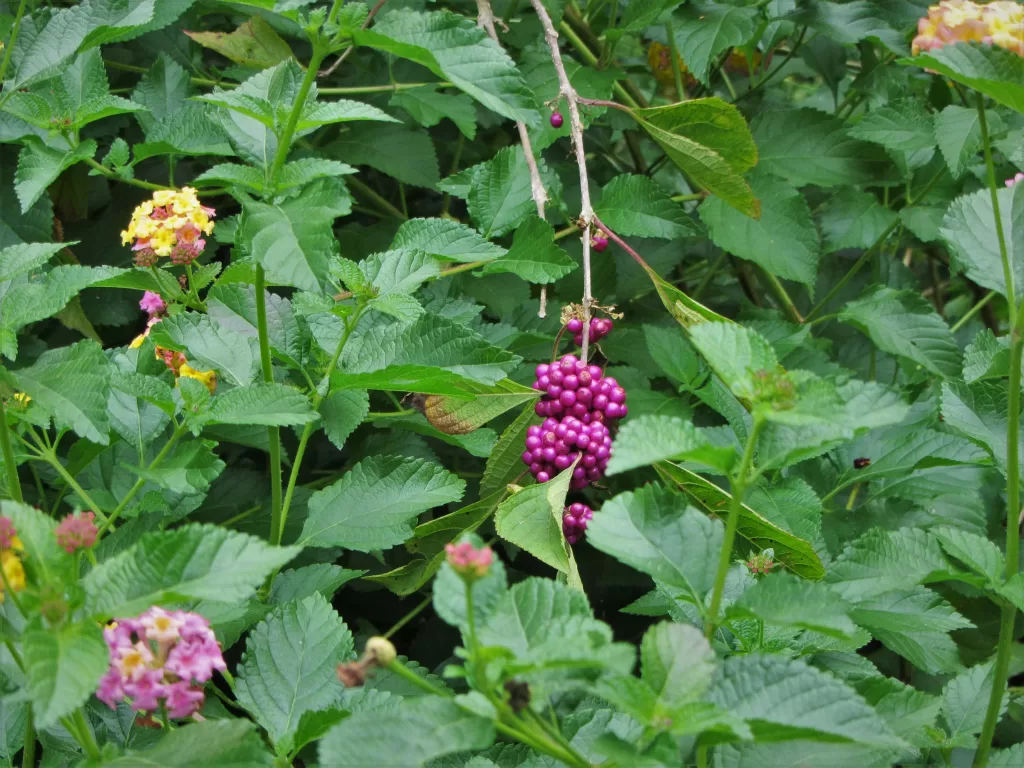
A native beautyberry shrub, Callicarpa americana, germinated in the middle of the Lantana bed one summer. It can be cut nearly to the ground each spring, like the Lantana, and grow back stronger than before during the following summer. Birds feed on the drupes in autumn.
I also noticed that the number of Lantana plants had increased. Lantanas have the super-power to root where their stems touch open ground. Soon, there were crowns with fresh stems throughout most of the bed. The Iris still claimed one side of the circle, and the rose persisted. But the bed, by now, truly belonged to the Lantana.
This spring, I didn’t get around to pruning the Lantana in February. Or in March, or April. I made a few half-hearted attempts, but soon realized that the English rose, which has languished in recent years with few blooms, was actually thriving behind its cage of Lantana branches. The deer couldn’t get close enough to nip off each bud and leaf as they developed. We had beautiful roses for the first time in years, and with no spraying of anything at all.
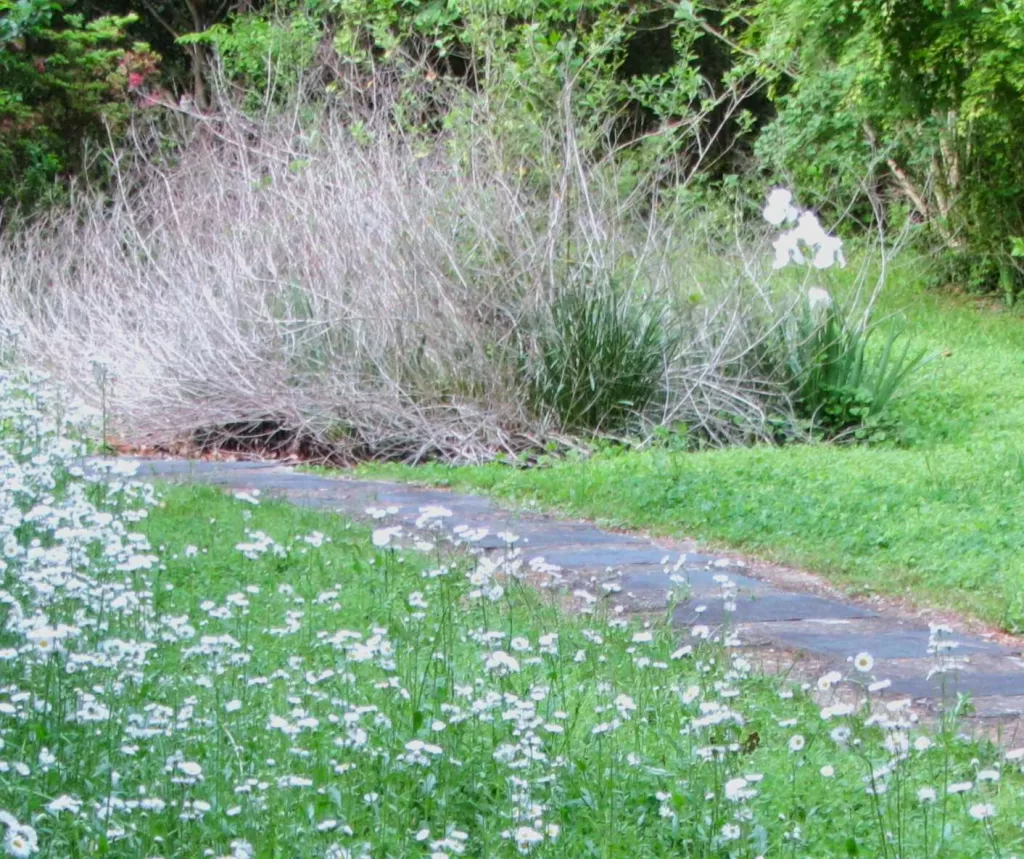
Late April of 2023 and I still haven’t gotten around to pruning back the Lantana. How totally embarrassing. It was a cold spring, and the birds were still using this bed for shelter.
I eventually cut back the Lantana branches around a good three-quarters of the bed, but never did finish the job. I was enjoying the rose growing happily again too much to remove its protection. As usual, the Lantana began leafing out in late April and early May. ‘Trimming the Lantana’ remained on my ‘to-do’ list into mid-June, when it became too hot to really care.
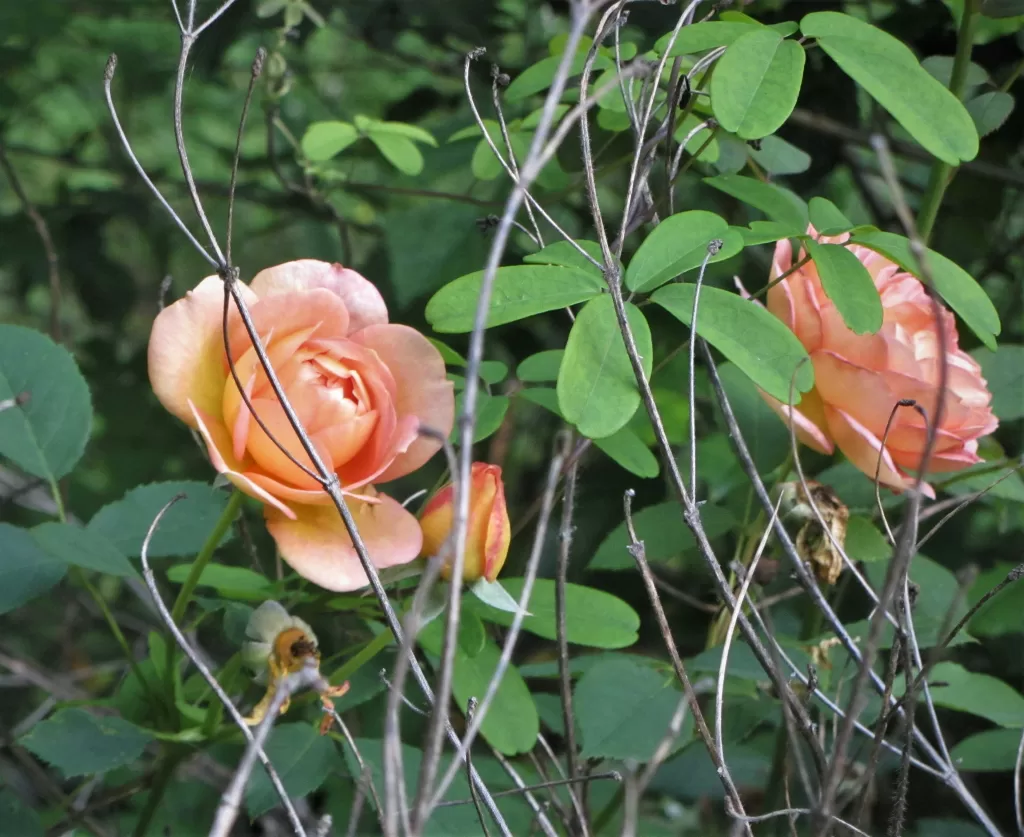
The roses bloomed for the first time in years, protected from browsing deer by the old Lantana stems, so my ‘Slacker Gardener’ attitude rewarded us after all. The Akebia vines had to go, however.
By mid-July, our Lantana was growing strong and covered in flowers. A stray Hibiscus bloomed on the Iris side of the bed. The holly, now tall enough to grow well above the flowers, was covered in berries. Who knew it was a female shrub? But best of all, we noticed that the Lantana sheltered more than our rose. It has become haven for wildlife.
We noticed the box turtles, first. We’d see them on the patio in the early morning, especially after a rain. When they retreated, they crawled back under the canopy of the Lantana. We have at least three different box turtles living in our yard.
We’ve always had rabbits, and we assumed they had their dens somewhere in the ravine behind our home. But now we watch baby rabbits, as small as kittens, venture out to nibble grass before retreating under cover of the Lantana. If they nibble a leaf here and there, there is enough Lantana that it is hardly missed.
Cardinals, and other songbirds, fly in and out of the Lantana branches. The branches are sturdy enough to serve as perches while the birds feast on insects. Bumblebees sleep, clinging to Lantana flowers, their breakfast ready when the sun warms and awakens them.
The Lantana varieties that have persisted and thrived in our round bed are L. ‘Miss Huff,’ and L. ‘Ham and Eggs.’ We’ve planted other varieties over the years, but they don’t have the same exuberant growth pattern as these. L. ‘Chapel Hill Yellow’ and L. ‘Chapel Hill Gold’ will overwinter in our yard. Both are among the several descendants of L. ‘Miss Huff.’ The L. ‘Chapel Hill Yellow’ that has bloomed in another perennial bed for the past seven years or more blooms late, and never grows to more than perhaps 2’ high. It tends to reach out laterally and is excellent in a raised bed to use as a relatively low groundcover.

A female Tiger Swallowtail feeds on L. ‘Miss Huff.’ Wild morning glory vines return each year from fallen seeds.
Lantana montevidensis will overwinter in beds, hanging baskets and containers. It always keeps a low profile and will cascade beautifully in a large container. It is a bit more tender and may not survive unusually cold winters. In the best circumstances, it won’t grow to more than a foot high unless you prop up its branches to grow vertically.
Our Lantana bed grows to about 7’ tall and perhaps 12’ wide as September draws to a close. I can sit on the patio, near the hummingbird feeder, and watch hummingbirds zip back and forth across the Lantana, then to the feeder, and on to the rose of Sharon growing nearby. Sometimes one will leave the Lantana to defend the feeder from an intruder.
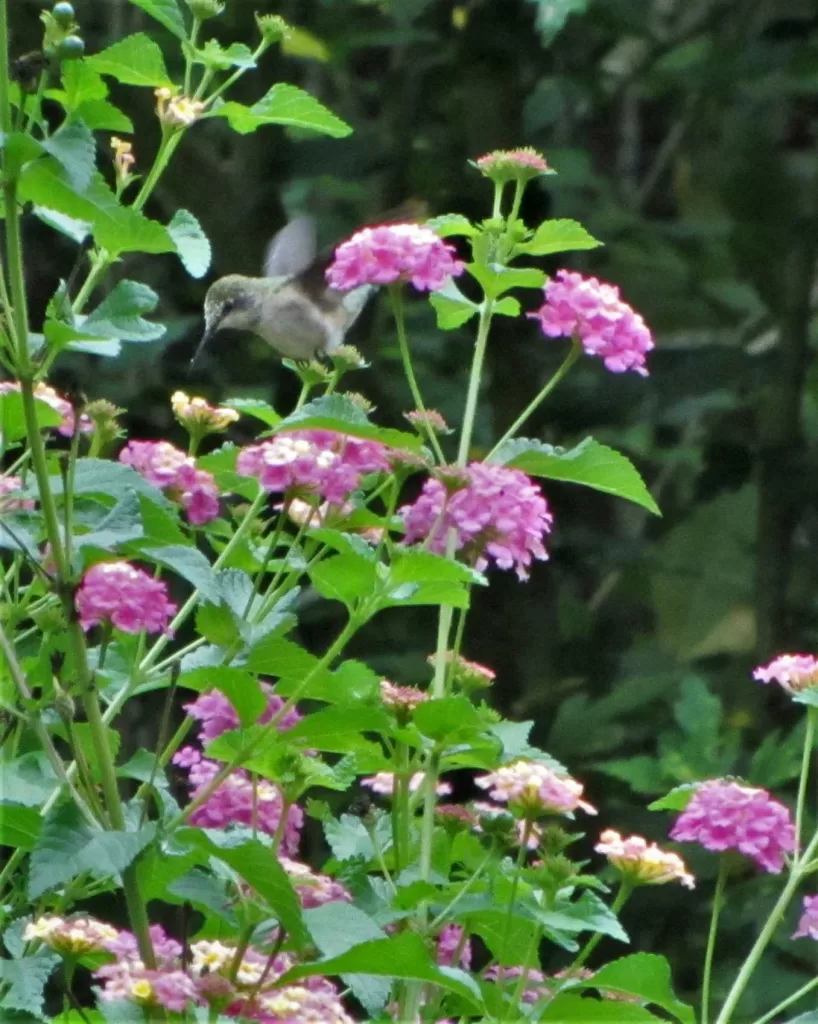
Our resident hummingbirds come and go from the Lantana from early morning until past dusk. There are plenty of places for them to perch and rest when they aren’t feeding.
We sometimes have four or five different butterfly species all feeding on the Lantana at once, with hummingbirds zipping in for a sip. All while rabbits, turtles, skinks, toads, and countless insects shelter beneath the dense cover. The Lantana has attracted more wildlife to our yard than I ever imagined.
Grow Lantana on most any soil from sand to clay. It isn’t picky about pH and rarely needs fertilizer. Add a little organic fertilizer as you plant it if that makes you feel better. Feed it with compost or mulch when you cut it back in the spring. It will only require watering if growing in a container, and then only during extreme heat and dry weather.
This is ‘sustainable gardening’ at its best, in my opinion. Few ‘inputs’ from the gardener are needed once the young plant is planted in the ground. Perhaps some mulch, and a good watering in on planting day. Then let the sun, wind and rain take over its care. And watch how this enormously generous plant welcomes every sort of pollinator, bird, and small hungry animal in need of shelter. And, it always welcomes gardeners, who want to rest a bit and watch the beauty of nature’s energy flowing endlessly from form to form, right in their own front yard.
All photos by E. L. McCoy






